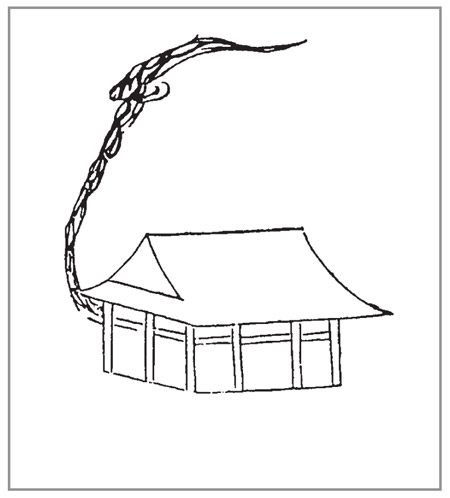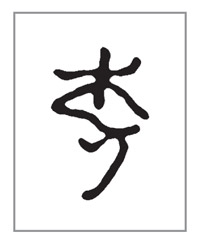In Search of the Niinja (35 page)
Read In Search of the Niinja Online
Authors: Antony Cummins


Chi
of a ninja.

The inverted bucket skill used to infiltrate an enemy place.
The next example is a perfect illustration of the difficulty in understanding if a text means a ninja or if it is simply someone sneaking in to a residence. The manual is undated, with this insert being the only ‘
nin
’ character found in the book, and also lacks any military instructions, which points to a non-ninja content, however the actions are still the same. The instructions in the text say that when you infiltrate (shinobi) into a house, you should write the name of the house master on a wooden bucket and then turn that bucket upside down. The house master will fall asleep, allowing you to enter.
The eighteenth-century Koka ninja, Ohara Kazuma, wrote down a selection of his family’s esoteric practices with a connection to ninjutsu. Based in Shugendo and dedicated to the god Izuna-gongen this spell is not for the faint of heart. It possibly displays the harsh world of ancient Japan and the lengths people would go to in order attain knowledge; or it is designed to emphasise the inestimable value of ninja secrets.
•
Catch a mating pair of deer and skin them alive, then dry and tan them in the shade.
•
Catch a pond turtle and put it in a tub of clean water and then place the plant
Cleyara Japonica
around the outside of the bucket.
•
For three days feed the turtle a small amount of alcohol.
•
Remove the shell of the turtle whilst it is alive with a knife. Whilst doing this you must say: ‘I am not doing this to you to wrong you, I am doing this to help the world and its people, to build a fruitful future, please forgive me.’
•
To bury the flesh and organs of the turtle you should use divination to guide you to a pure place. Here you must build a small shrine in secret and dedicate it to the god Izuna-gongen.
•
Dry roast the shell in a lidded earthware pot and include some
Rhus Javanica
wood. When this has blackened grind this down into a powder.
•
Cut the male deer skin into a rectangle of 84cm long by 9cm in width.
•
Cut the female deer into a rectangle of 78cm long by 9cm in width.
•
Mix the burnt shell powder from above with glutinous rice powder to make glue.
•
Apply this glue to the back of the skin to make a single talisman.
•
Now as it is made of male and female it is now both male and female, that is In-Yo, and next, install it on the shrine that you have created. Pray each day at this shrine from 3 March to 5 May. This is the period between the festival for girls and the festival for boys. When you are praying you should say this spell:
•
‘
Takamagahara ni kami todomarimasu kami no manako no konoizuna kikitomete haraetamae kiyometamou
’ [‘Izuna and the realm of the gods, hear my prayer and fulfil my wish and purify’].
•
When you have chanted this spell, you should make your wish and ask the god Izuna-gongen to fulfil your wish and show you the secrets of the ninja.
•
After the last day of the above mentioned period you should take the talisman and carry it with you.
The above spell is from the
Inko-ryu
which, along with
Fukushima-ryu,
show a heavy slant towards magical skills, alongside historical ninjutsu. The
Fukushima-ryu
is thought to have been passed down in the family of Fukushima Saemon Dayu and to have been connected to the Nojiri family through Nojiri Jiroemon Narimasa. The
Fukushima-ryu
manual deals with some very esoteric areas, some of which are not fully understood, as seen below:
•
The subtitles [of ninjutsu?]
•
The spider hand
•
Dream and fantasy [ninjutsu?]
•
‘The pulling of your body’
107
•
Attacking and defending
•
Defence against Juji magic
108
The
Koka Ryu Bujutsu
manual also includes magical spells among its lists. Samples from the document:
•
Explosives
•
Magical spells
•
Medicines
•
Signals
•
Torches
•
Sleeping powders
•
How to identify secret letters
•
How to get water from sea water
•
Charms and talismans
•
Sea sickness cures
The
Inko-ryu
document contains the following list:
•
Of breathing
•
The art of whistles
•
Seeing at night
•
Skills and tools of the shinobi
•
Poisons
•
Removing poisons
•
Important points to be used at night
•
Things to do in the dark without a light
•
Magical spells
The Fukushima document has some interesting melding of the esoteric and the practical. Here is how to ‘defend’ your saw or drill against sound by magical means. Whilst possibly symbolic or considered magical, the mixture would in fact work as a lubricant to reduce noise, just as the ‘oil of toad’ would for the saws in the
Shinobi Hiden
manual. ‘If you apply a mixture of newt and owl blood mixed in with sake, and apply it to your saw, you will cut without noise or if applied to a drill it will become a magical drill.’
The
Fukushima-ryu
also holds a spell of hiding, the ‘Spell of the Blind Buddha’: ‘Write the spell [overleaf] on the belly of a Buddha [statue] and write the Sanskrit image found below on its back. When you write this, do it in the blood of a weasel.’
The
Shinobi No Maki Te Kagami
describes a poem that is said to entice your enemies into the open. The explanation is not extensive and it is presumed to be a form of mantra to bring your enemy into a position that you would want them in. ‘
Ken no to chigiri shuto o wasurete kazoo no ineshie no bushi no hito moto.
’
Sometimes, the esoteric elements of ninja manuals sound outrageous but it has to be remembered that most of these scrolls are from a time of widespread superstition. The
Shinobi No Maki Te Kagami
ninja scroll even claims to hold the key to seeing the dead and spiritual beings. The instructions are ambiguous, however, the general procedure is as follows: dry a red (possibly brown/red) cat and take ointment from it and then apply it to the edges of one’s eyes. The ‘magician’ should dry bat’s eyeballs in the shade. The manual then becomes almost incomprehensible. He should perform an unknown action to a beehive, possibly create a hole or taking a section and, along with the bat’s eyes, add the extract to the edges of his eyes. The dead or those things that are part of the supernatural world are then made visible.


Rather than be surprised by such superstition, the modern reader should be more shocked by the shinobi’s theme of
non-reliance
on magic, one which flows through the main manuals. The ‘psychological’ magic mainly found in the true ninja manuals contrasts with the the more outlandish magic found in the less historically authentic manuals.
Notes
103
A helpful guideline for ninjutsu manuals is the idea that a manual should be practical and have some form of psychological magic to aid the ninja; if a manual is purely magical with next to no ninjutsu, then it is more than likely a later fiction. However, some manuals fall into a middle category and each manual must always be tested independently.
104
Next to no ninjutsu is actually recorded within this manual.
105
The original states to ‘chant in the mouth’ meaning in silence, or in your head.
106
At present this
mudra
is unknown, but the best theory to date is the
mudra
of Zen. The
Kuji
for ‘Zen’ is connected to both the word
Ongyo
and the goddess
Marishiten,
which would make it the best option for this skill.
107
This is a literal translation and is probably an idiom used for an unknown skill.
108
Literally ‘
Juji
pushback’.
Oral Traditions â The Ninja Way of
Kuden
How to construct useful tools should be passed down by âhand to hand' transmission, such things as fire arrows, torches, watch-fires etc, should not be gained without direct teaching.
Taken from the
Onmitsuhiji shinobi-daii
E
mbedded in the way of Japanese arts, be it the martial arts or other skills and especially in
shinobi no jutsu
, the term â
Kuden
' is bandied around in conversation and is half understood.
Kuden
is oral tradition and that which is passed on by teacher to student alone. It is made up of two ideograms,
Ku or âmouth' and
or âmouth' and
Den for âtransmission'. Also, this alternative ideogram for
for âtransmission'. Also, this alternative ideogram for
Kuden
was sometimes used: .
.
